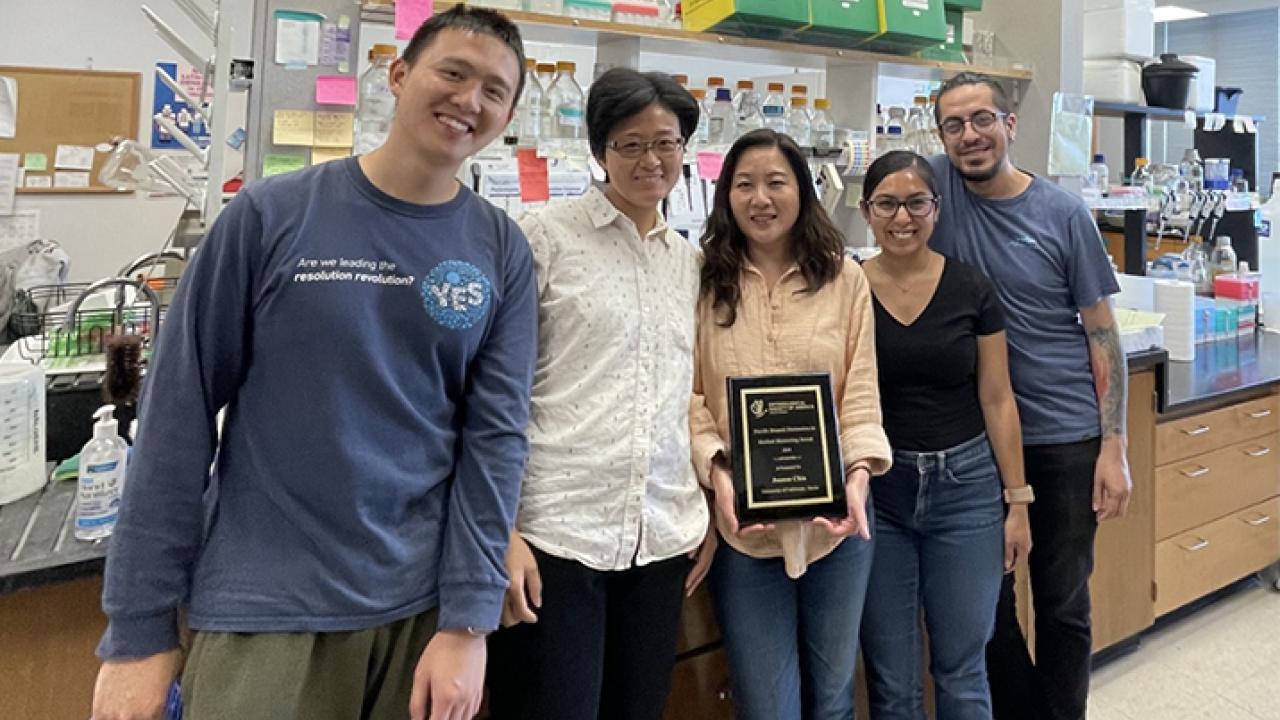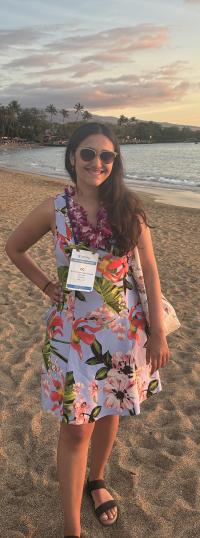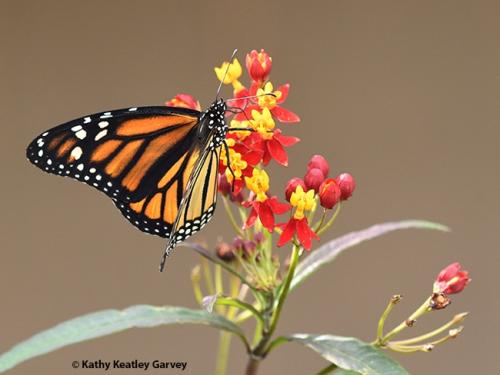
Focus on UC Davis at PBESA Meeting in Hawaii

Molecular geneticist- physicist Joanna Chiu, professor and chair of the UC Davis Department of Entomology and Nematology, took home one of the highest academic awards presented at the recent meeting of the Pacific Branch, Entomological Society of America, held in the city of Waikoloa Beach, Hawaii.
Her award: the Distinction in Student Mentoring Award.
Nematologist Steve Nadler, professor and former chair of the department, nominated her for the mentoring award. He praised her as “an incredible mentor, inspirational, dedicated and passionate about helping her students succeed, as exemplified by her receiving the 2022 UC Davis Academic Senate Distinguished Teaching and Mentoring Award for her contributions to graduate student and professional mentoring, and the 2023 Chancellor’s Award for Excellence in Mentoring Undergraduate Research.
Chiu is noted for providing her trainees, many of whom are from underrepresented groups, with very effective career and academic advising,” Nadler noted.. “For example, many first-generation and underrepresented undergraduate trainees from her lab are now successfully enrolled in prestigious biological PhD programs, including programs at Stanford, Cornell, Columbia, UC Berkeley, UCLA, UC Irvine, UC Davis, and UC San Francisco. Under her tutelage, her students are first authors of publications in prestigious journals. Even after her undergraduate and graduate students leave the university and settle into their careers, she continues to provide guidance and advice to them.” (See news story)
It was PBESA's 108th annual meeting.
Ian Grettenberger Laboratory


The laboratory of Ian Grettenberger, assistant professor of Cooperative Extension, organized and presented a symposium on “Same Bugs, New Tricks: Innovation in IPM in the Western United States."
Presenting talks were Gettenberger; postdoctoral scholar Buddhi Achhami; and doctoral student Addie Abrams.
Grettenberger discussed “Spray Coverage in Lettuce: Challenges for Management of Key Arthropod Pests.” Achhami presented at talk on "Factoring in Spray Coverage: Exploring the Dynamics of Insecticide Applications for Aphid and Whitefly Management in Cotton."
Abrams chose “Precision Insecticide Sprays for Integrative Pest Management of Aphids and Thrips in Lettuce Crops."
"Our lab studies agricultural entomology, and we do research and extension in California’s field and vegetable crops," Grettenberg writes on his lab website. "We aim to develop pest management strategies for arthropod pests using principles of insect ecology, a solid understanding of a pest’s biology, and how pests and their natural enemies respond to management actions.

"California has a huge diversity of crops within the field and vegetable crop categories, each with distinctive pest challenges," the Grettenberger lab website points out. "We have active projects in a number of these crops, so please see RESEARCH for an overview of some of these projects and TEAM for our team members working in these systems.
CC Edwards of Geoffrey Attardo Laboratory
Carla-Cristina "CC" de Melo Edwards, a master's student in the laboratory of medical entomologist-geneticist Geoffrey Attardo, entered the graduate student research competition with her presentation on "Resisting Resistance: Identifying Biochemical Biomarkers for Pyrethroid Resistance in Aedes aegypti Mosquitoes."

The abstract: "Over the past decade, the invasive Aedes aegypti (yellow fever mosquito) has increasingly colonized California, complicating vector control efforts due to its resistance to pyrethroids, the primary insecticides used for control. This study aims to elucidate and evaluate potential biochemical biomarkers associated with metabolic mechanisms conferring pyrethroid resistance. By dissecting these mechanisms, our research seeks to facilitate the development of targeted assays for novel resistance biomarkers to improve monitoring capabilities and identify and evaluate novel synergistic compounds."
Ziv Lieberman of the Phil Ward Laboratory
Doctoral student Ziv Lieberman of the laboratory of Phil Ward, professor and ant specialist, delivered a general presentation on "Male Genital Skeleton Musculature of Hymenoptera: Homology and terminology in Leptanillinae and Beyond."
The abstract:
"Insect male genitalia are indispensable to entomologists, as sources of phylogenetic signal in systematics, and as a rich and diverse character system in comparative morphology, functional biology, and study of evolutionary dynamics. The enigmatic ant subfamily Leptanillinae (Hymenoptera: Formicidae) differs from most other ant lineages in that classification thereof relies more fundamentally on male phenotype than that of workers due to peculiarities of life history. The degree and variety of spectacular structural modification of the leptanilline male genitalia are also exceptional, not only relative to other ants, but to the Hymenoptera more broadly. In order to contextualize these bizarre animals in relation to the evolution of the Hymenoptera, we comparatively study the male genital phenotype across all major lineages in the Leptanillinae, with direct comparison to outgroup ants representing the major formicid radiations. We further align our observations with historical and recent work across the remaining Hymenoptera, leading us to develop a male genital skeletomuscular terminology system that is consilient with schemata for other orders and tagmata. Our approach is homology-explicit and is congruent with skeletomuscular identity across the Hexapoda. Here, we highlight the importance of musculature in studying homology, discuss our system in relation to other recent terminological recommendations, and reflect on opportunities for co-illumination proceeding from different approaches to morphology, from morphemic, homological, and ontological perspectives."
Madison Hendrick of the Ian Grettenberger Laboratory
Madison Hendrick, a doctoral student in the Grettenberger lab, entered the graduate student research competition with "Biocontrol or Poke Bowl? Using Mosquito Fish as a Biological Control Agent for Tadpole Shrimp (Triops longicaudatus) in California Rice Fields."

The abstract:
"The primary pest of California rice is a freshwater crustacean known as tadpole shrimp (Triops longicaudatus; TPS). The shrimp damage rice by directly feeding on the germinating plants and by dislodging seedlings as they forage for food in the mud. Severe infestations can cause significant stand loss. Despite their key pest status, control options are effectively limited to pyrethroid insecticides. Biological control is an integrated pest management strategy that could benefit TPS management. Mosquitofish (Gambusia affinis) are larvivorous fish released in rice fields as vector control and have been shown to feed on TPS. We conducted field studies in 2022 and 2023 evaluating the efficacy of mosquitofish as a TPS biocontrol agent. Trials testing the minimum density of fish needed for control were conducted both years. Fish application timing was tested in 2023. All studies used 100sqft metal-edged plots in a randomized block experiment. Plots were built before fields were flooded. In density trials, fish were added immediately after flooding at different densities. In the timing trial, fish were added at different intervals at the same density. In all density trials, we saw a reduction in shrimp numbers, with minimal treatment effects. In the timing trial, we again saw a reduction in the number of shrimp with no significant difference in treatments. Evaluating the best fit of various control methods is important for creating IPM programs. As is, the use of fish for biological control appears to be challenging at best, though further studies may be necessary."

Insect Photo Salon
UC Davis-affiliated photographers won two of the three prizes awarded in the insect salon. Photo Salon coordinator Joshua Milnes, an entomologist with the Plant Protection Division, Washington State Department of Agriculture, Yakima, announced the winners as:
- First, Robert Peck, entomologist with the University of Hawaii, for his image of a damselfly
- Second, Alexander Nguyen, a UC Davis entomology alumnus, for his image of a blowfly
- Third, Kathy Keatley Garvey of the UC Davis Department of Entomology and Nematology, for her image of a monarch.
The photo competition, themed “Pineapple Madness,” was open to all PBESA members. Membership covers 11 Western states, plus U.S. territories and parts of Canada and Mexico. (See more)

Alexander Nguyen. “I took this image (of a blowfly) while visiting my good friend, and fellow UC Davis entomology alumnus Joel Hernandez, in Woodland," Nguyen said. "I'm a long time user of Canon cameras and have no plans to switch. This was photographed using the newer R5 mirrorless model. I currently reside in Sonoma County serving that region in the Agricultural Commissioner's office.” This was his third win in an ESA-hosted competition. Nguyen's image of a hoverfly, photographed in the UC Davis Stebbens Cold Canyon Reserve, won an international competition and appeared in the ESA 2018 Insects of the World calendar. (See Bug Squad blog) In 2022, his photo of red imported fire ants placed second in the PBESA Photo Salon.

Kathy Keatley Garvey. Garvey, a communications specialist with the Department of Entomology and Nematology, captured her image of a monarch foraging on milkweed in a Vacaville garden. Her camera gear: a Nikon D500 with a 200mm macro lens. She earlier won several awards in ESA-hosted competitions. Her image of a golden dung fly, Scathophaga stercoraria, won the Entomological Society of America (ESA) medal for "Best Image by an ESA Member" in the 64th annual International Insect Salon competition, held in 2022. Her image of two Melissodes agilis bees buzzing over a sunflower, Tithonia rotundifola, won "Best Image by an ESA member" at the 63rd North Central Insect Photographic Salon, co-sponsored by the North Central Branch of ESA and the Photographic Society of America. Two other Garvey images also won acceptances in the North Central competition.
(See complete program on PBSA website.)
The 2025 PBESA meeting will take place March 30-April 2 in Salt Lake City, Utah. See photos on Flickr from the PBESA's 2024 meeting.
